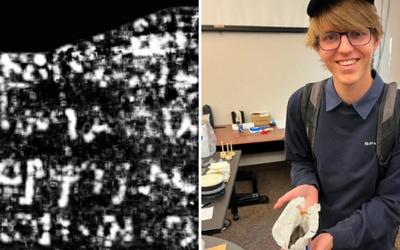Using artificial intelligence (AI), three very talented students have accomplished an incredible feat: deciphering a 2,000-year-old scroll that was burned during the Mount Vesuvius eruption in 79 AD. The level of preservation of this old writing rendered it illegible until its discovery in the Roman town of Herculaneum, which was destroyed in the same manner as Pompeii during the volcanic eruption.
Who were the three students who cracked the code With The Help Of AI ?
! The following three very intelligent people deciphered the code of the 2,000-year-old scroll scorched by Mount Vesuvius eruption:
- Youssef Nader: A Berlin-based graduate student studying biorobotics from Egypt.
- Luke Farritor, a Nebraskan interning at SpaceX who is also a college student,.
- Julian Schilliger: A Zurich-based student studying robotics.
Equipped with the ability to utilize artificial intelligence (AI), these three students accomplished a feat that had defied academics for millennia. Together, they cracked apart the old scroll’s 2,000 characters to uncover its hidden meanings and shed insight on the Greek philosopher Philodemus‘s writings on food and music. A truly amazing combination of modern technology and ancient understanding[1][2].
The scroll, which is said to have belonged to Julius Caesar’s father-in-law, has conversations regarding food and music. This discovery is regarded by experts as a revolution in Greek philosophy. The authorship is reminiscent of the Greek philosopher Philodemus, who adhered to Epicurus‘s** ideas and might have been Herculaneum’s philosopher-in-residence.
The Vesuvius Challenge: These three students took part in a competition where the goal was to use machine learning algorithms to interpret the text on the burned scroll.
A previously undiscovered philosophical treatise attributed to the Greek philosopher Philodemus was discovered within the scroll by their AI-assisted efforts. The scroll had been carbonized during the volcanic explosion that buried the ancient Roman town of Herculaneum and had been hidden for 2,000 years.
The Secret Disclosures: The interpreted passage talks on pleasure and the senses, including things like music, the flavor of capers, and the color purple as enjoyable experiences.Experts in the field of ancient studies have expressed enthusiasm at this ground-breaking accomplishment, calling it a “historic moment” and a “pipe dream come true.”
Consequences and Future Prospects: • The Vesuvius Challenge’s accomplishment indicates that artificial intelligence approaches have the potential to decipher the mysteries of ancient writings.
•This discovery, according to researchers, has the potential to completely change our knowledge of the ancient world.
•Students who discovered this hidden treasure will split a $700,000 grand prize.
In essence, their work reveals a long-lost piece of human knowledge by combining cutting-edge technology and age-old wisdom in a unique way.
Here’s how this fascinating discovery unfolded

- The Charred Scrolls: Hundreds of papyrus scrolls were discovered in the library of an opulent Herculaneum palace in the 18th century. The only texts from the Roman era that still exist are found in these scrolls. Unfortunately, attempts to unroll them resulted in their collapse since they were burned so badly by volcanic material. But the eruption’s high temperatures unintentionally carbonized and preserved the inscriptions, stopping their normal breakdown.
- CT Scans and the Ink Mystery: Using high-resolution CT scans, Dr. Brent Seales and his colleagues at the University of Kentucky meticulously unrolled the manuscripts last year. Nevertheless, the papyrus itself could not be deciphered from the black carbon ink that was employed on the scrolls.
- The Vesuvius Challenge: In partnership with tech investors, Dr. Seales introduced the Vesuvius Challenge, with a $1 million prize up for grabs for anyone who could decipher the code. Now for the trio of students: Youssef Nader, a PhD candidate in Berlin; Luke Farritor, a student and intern at SpaceX; and Julian Schillinger, a student studying robotics in Switzerland. Using AI was part of their unorthodox strategy.
- Artifice Interprets the Text: The pupils created an artificial intelligence model that utilized pattern recognition to decipher the characters. 2,000 Greek characters have been decoded by the model thus far from one of the four scanned scrolls, or about 5% of the text. The translated characters showcase the author’s conversations about life’s joys, including food and music. Philodemus, for example, queries if scarcity enhances enjoyment:”as too in the case of food, we do not right away believe things that are scarce to be absolutely more pleasant than those which are abundant” ¹
With this incredible accomplishment, Greek philosophy enters a new era as AI unlocks the mysteries of an old scroll that has lain dormant for generations. Indeed, a synthesis of modern technology with ageless knowledge